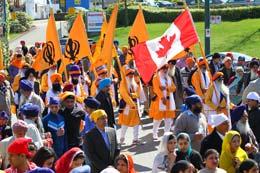Vaisakhi celebrates founding of Khalsa movement

Photo: Pall Beesla
Sikhism as it is known today began at the dawn of 1699 in India.
The faith’s 10th teacher, Guru Gobind Rai sent out word to congregants to gather at his temporal seat of authority: Anandpur Sahib, Punjab, India.
Vaisakhi, the annual harvest festival that marks the start of a new year, was to be unique. The time had come to crystallize the practices and beliefs of the Sikh faith.
As hundreds of thousands gathered around this holy place, Guru Gobind Rai called for five volunteers, whom he would baptise – these would become the anointed “beloved ones” who formed the new order of the Khalsa, or ‘saint-soldiers’.
Then the Guru knelt before them and requested they initiate him in a similar manner. All the men who were baptised were given the surname Singh. He then pronounced that all Sikh women will carry the surname Kaur. His own name became Guru Gobind Singh.
With that edict, the Khalsa, the order of the initiated Sikhs, was created. It gave the community a unique identity which stresses a life dedicated to principles of spirituality, morality, equality and justice – an identity which carries through to this day.
Vaisakhi today is known all over the world as a Sikh celebration, but not many know its roots stem from a harvest festival that nurtured religious freedom and community giving.
Guru Gobind Singh chose the festival day of Vaisakhi as the occasion to transform the Sikhs into the Khalsa, a family united as one regardless of caste, colour, race or gender.









